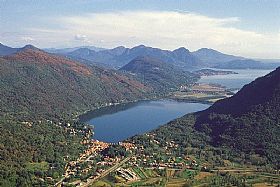Baveno

A picturesque town on the shore of Lake Maggiore north of Stresa, Baveno faces the romantic Borromean Islands and backs to the green hills surrounding the lake. The town of about 5,000 residents has seen a very long history, starting with prehistoric human existence. The many archeological finds testify to the many millennia that have touched this area. The Romans left evidence in the way of necropoli, domestic wares, funerary items and coins. The town was along a crossroads between Ossola and the Alps, and later between Genova and Venzia, making it stragetically important with a once-flourishing commercial port.
The area also became noted for its rose granite quarries, prized during the Renaissance. In the 1600s, chapels were built scattered around the hills of the area, for devotional walks in a panoramic position. In 1807, the Strada del Sempione opened, a project of Napoleon's that connected Paris to Milan. In 1826, the first steamships started plying the lake's waters from here, with a restaurant onboard for comfortable traveling. Baveno became a popular "last stop" on the Grand Tours of Europe, a place to rest and relax before heading home to their northern countries. The railroad arrived in 1906, connecting Lake Maggiore to Switzerland.
There are many monuments to see around town and around the outlying hamlets. Baveno takes in several villages: Feriolo, Romanico, Oltrefiume, Roncaro, and Loita. Each has its own beauty and customs, and there are paths connecting them, for walking enthusiasts. You'll be rewarded with lovely ambiance and great views!
Around the centro of Baveno, you can't miss the Complesso Monumentale -the heart of the town. It leaves visitors with a lasting impression at the architecture and beauty.The Romanesque Church called Prepositurale is reached by a staircase. It dates back to 1133, but a Roman carving was uncovered on its facade in 2000 during restoration works. The church is dedicated to two saints, both Roman martyrs - San Gervasio and San Protaso, and holds many beautiful frescoes. The saintly paintings in the side chapels are worth seeing. It bears a Romanesque bell tower from 1075. Next to it is the octagonal Baptistry, even older than the church. It dates to the 5th century, but its interior was completely frescoed in the 16th century recounting the life of St. John the Baptist. An interesting feature is the arcade that is part of the complex, a frescoed open-air and covered Via Crucis.
There is the Museum Granum in Palazzo Pretorio, a multimedia geology museum dedicated to the area's rose granite and other stone and its mining history.
Also, be sure to visit one of the villas and gardens. Villa Fedora with its public park, and Villa Mussi also has a public garden. Of course, the lakefront gets the majority of the attention, rightfully so. The nice walkways skirt the water and look at those evocative islands. You can rent a boat or schedule a tour to see some of the beauty of this place from the water. Walking paths connect the villages, with a variety for those who want gentler walks and those who are trekking enthusiasts, and there are mountain biking trails, too.
Enjoy some of the lake's fried fish, called alborelle, the chestnuts and mushrooms from the hills, and the Alpine-grazed cheeses.
Photo Credit: https://commons.wikimedia.org/wiki/User:Abxbay
Rent a holiday home in Baveno and travel like a local.

 Amalfi Coast
Amalfi Coast Sorrento Coast
Sorrento Coast Tuscany
Tuscany Cilento National Park
Cilento National Park Lake Como
Lake Como Rome and Latium
Rome and Latium Umbria
Umbria Capri and Ischia
Capri and Ischia Venice
Venice Puglia (Apulia)
Puglia (Apulia) Liguria
Liguria Sicily
Sicily Lake Maggiore
Lake Maggiore Lombardy
Lombardy Sardinia
Sardinia Lake Garda
Lake Garda Abruzzo and Marche
Abruzzo and Marche Calabria
Calabria


Been there? Done that? Share your experience and tips!
Haven't visited yet? Have questions about Baveno? Ask them here!